If you're cod, this is a killing field . Bunches of dried fish twist in the wind from birch structures the size of cathedrals, and fishing boats are loaded with radar, hoisting systems and fish-finding equipment.
If you are an artist, this is a land of light clear and simple , which is why so many others have come to develop their careers over the last century and a half. If you are a visitor, this is where the mountains shoot out of the sea as if they were fins , their reflections dive to the unfathomable depths of the fjords and the sweet wooden houses are grouped by shades of lemon, gray, brick and sky . But don't get mad if you float off the road delimited only by red snow markers because of the thaw.
The lofoten islands they can hardly qualify as an archipelago. They look more like some kind of vestigial organ off the coast of Norway (100 kilometers above the Arctic Circle and 230 south of the city of Tromsø) connected to the mainland by a bridge about a kilometer long. More bridges, surrounded by innumerable rocks and reefs, connect the seven main islands.
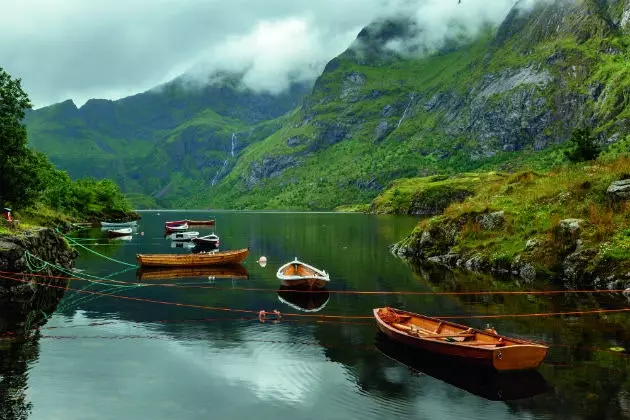
Traditional boats rest on the Ågvatnet lake.
There are fish all over. Flash through history and swims in the depths of Art. It is the backbone of everything, because these islands happen to be the perfect place – not too cold, not too hot and with constant wind – for the production of a dried cod with a denomination as appreciated as that of any champagne or Iberian ham and with more than 20 quality levels. The Vikings exported it throughout the known world. They still do: the bodies for southern Europe, the heads for Nigeria; the roe turns into caviar of the Lofoten Islands and in the stores sell small pieces of cod as an appetizer.
I dropped by to visit NNKS, or Nordnorsk Kunstnersenter, an artists' cooperative in Svolvær , the de facto capital that is not even a city. Silvery fish swam in circles along its huge white walls, chasing each other for all eternity, and sea urchins hung from a felt net, dozens upon dozens of them as fragile as eggshells. “Codfish?” I asked, pointing to a fish skin purse. “ Salmon ”, they replied while shaking their heads.
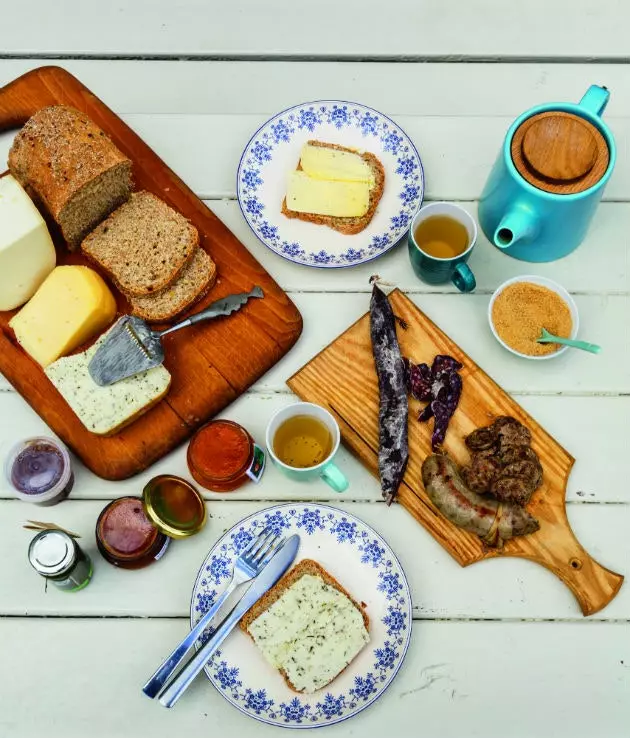
Gastronomy in Lofoten.
My hotel room was a robu , either ' fisherman's hut ’, a surviving cabin from those days when boats with square sails pointed their bows towards the open sea in search of wind. There are hundreds of these shacks in Lofoten. They rest on stilts so that the boats could be moored and the fishermen could take a nap on those bunks where the head of one coincides with the feet of the other. Today are cozy vacation cabins with cheap cotton curtains and oil lamps. Mine had a terrace overlooking the harbor.
I stayed for a while chatting with the man who attended the old warehouse general of Svinøya , an islet off Svolvær. The store was just as it was when they supplied everything from leather boots and fishing hooks in 16 different sizes to tobacco tins and photos of King Haakon VII of Norway. Now, its owners organize different activities such as alpine skiing, hiking and night walks to see the northern lights and, in addition, they take care of the elegant restaurant next door called Børsen Spiseri.
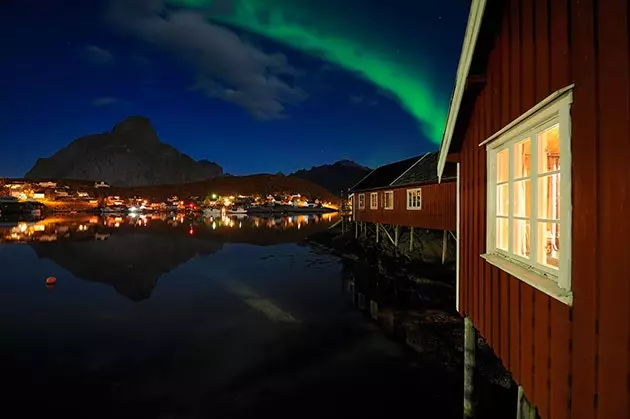
Lofoten Islands: dream paradise.
“Cutting cod tongues is what a lot of kids here do as a temporary job during their vacations,” the man behind the counter told me. "Some take off up to €3,000 per week . The fried cod tongues are a delicacy ”, He added noticing my shocked face and my horrified expression.
I had to try them. So I decided to stay. I am grateful to the French chef for eschewing fried tongues in favor of a delicate smoked whale carpaccio –just a bite– dried fruit and horseradish filling . Completing the menu: cod with saffron aioli, arctic trout fillet with crispy leeks and vanilla ice cream and arctic berry, as a final touch. The laughter of several rosy-cheeked Norwegians bounced off the walls as I drank a €12 beer and thought about the next day's route. Svolvær is on the island of Austvågøya , and my destination was four islands away, 120 kilometers west of the island of Moskenesøya , home to the villages of Reine and Å (pronounced 'o'). It is literally at the end of the road: so you need a boat to cross, both to and from the sinister swirl caused by the tides and known as the Maelstrom.
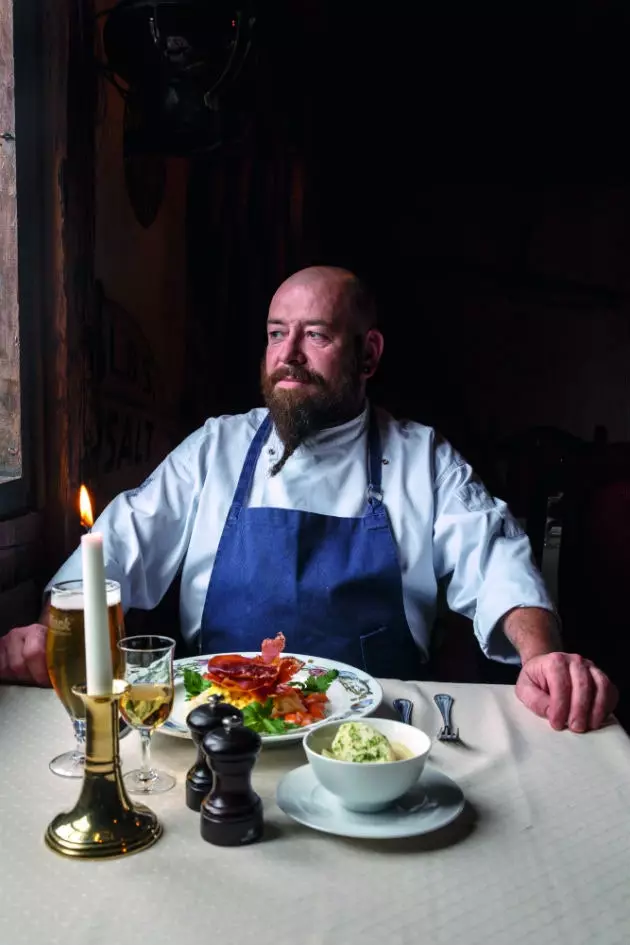
Not everything is Salmon in Lofoten.
The next morning in Kaviar Factory (an ice cube-shaped art gallery Henningsvær), its owner, Venke Hoff, nodded when I told her that she had almost crashed me with the car because of the beauty of the landscape. “ You have simply done a spectacular national route She said-. We came here, first of all, because the lighthouse was for sale (we bought it without internet). Then, once installed, we thought: this site is really amazing!”
Hoff and her husband have been collectors for 30 years. They lend their lighthouse as a residence for promising artists –The Spanish Ángela de la Cruz, nominated for the Turner Prize , she lived here a couple of years ago – and, in 2013, they decided to convert a nearby abandoned factory into the KaviarFactory gallery. The truth is that they had the help of some of their friends: the German artist Michael Sailstorfer turned the gallery sign into a conceptual piece, with several letters missing; Bjarne Melgaard (“who is said to be our most talented artist since Munch”, they assure me) designed the door handles, and the extreme artist Eskil Rønningsbakken she is known to balance the top of the building. A section on the upper floor looks down, just above a machine placed in a pool of oil by the Paris-based Norwegian Per Barclay. The windows frame a pale amethyst sea dotted with flaky rocks.
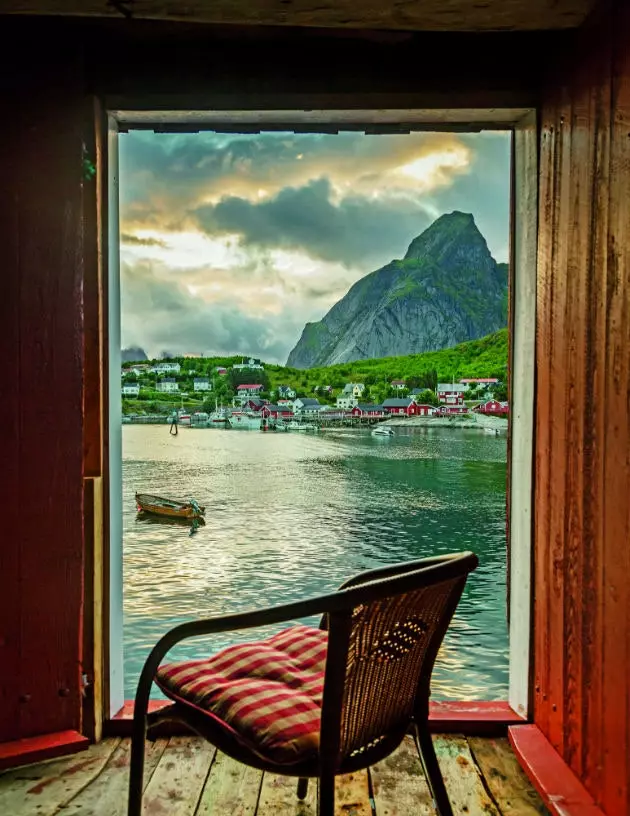
Windows overlooking a pale amethyst sea dotted with flaky rocks.
“Come see my flat,” Hoff invited cheerfully, and presently I was climbing a flight of polished concrete stairs—each step with a pair of shoes at one end—that emerged into a space in the living room. home-office filled with the crystal clear light of Lofoten . She smiled and shook her head, as if she didn't quite believe how lucky she was. She also took me to a candle factory that is a cafeteria. Run by the maker herself and her husband, a fishing skipper, it was packed with people eating cinnamon buns and tourists buying candles. Down towards the harbor, a study of ceramic and glass objects gleamed in a former cod liver oil factory . At the roadside delicatessen I couldn't take it anymore and ended up buying a jar of cod roe in tomato sauce
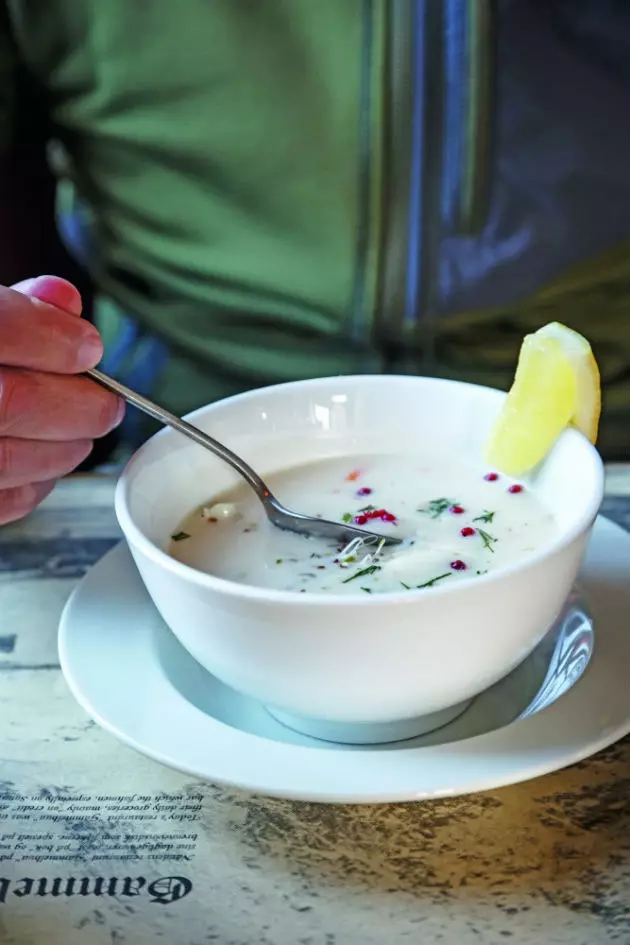
Lofoten and its varied gastronomy.
"I make them myself," the smiling owner assured me, holding up what looked like a pair of lungs. These are the roe bags, and then you mix the eggs with salt and pepper and a little bit of sugar.” She told me that at some point in Lofoten's long export history, ingredients and ideas had been brought from the Mediterranean. “ We started using tomatoes and garlic much earlier than in the rest of Norway, and we have always used spices She told me-. but in winter I make traditional food, strong , because I feed a large number of fishermen. Otherwise, I always mix everything.”
Following the road there is a huge giant gray box next to the fjord. When you get closer, you realize that it is a curved mirror facing water: I could see myself in triplicate, dwarfed by the landscape . It is from the American artist Dan Graham and is part of Artscape Nordland , a set of more than 30 sculptures scattered throughout the islands, including works of Anish Kapoor Y Antony Gormley . It seemed most appropriate to me: artists began to arrive here in the 1860s, swept up by the ' empty beauty ’ from the islands, and they haven’t stopped coming ever since.
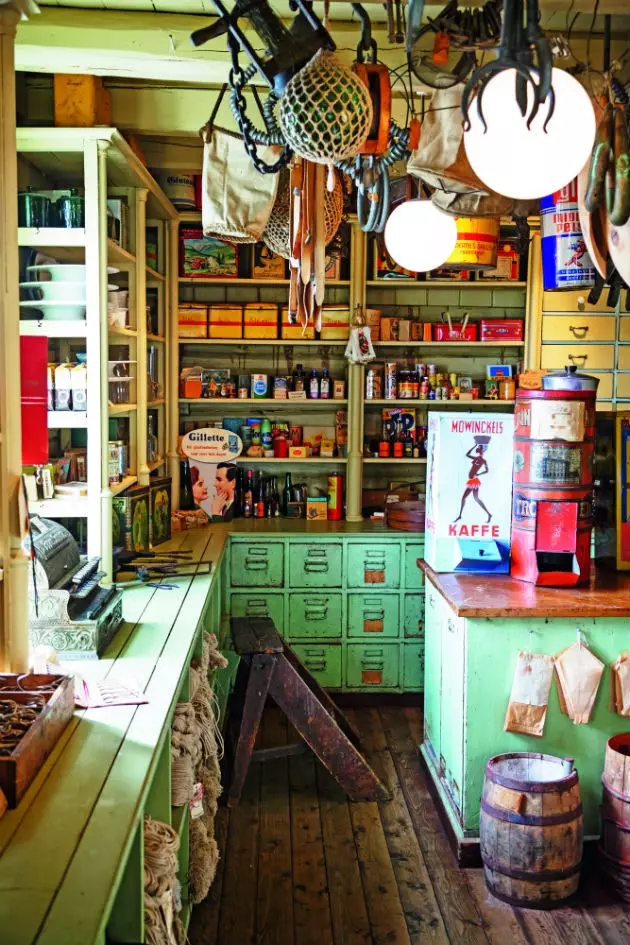
Shops in Lofoten where they usually give salmon as an appetizer.
As he drove, the landscape unfolded like a reel of film: the grassy plains of Vestvågøya , the houses with concrete foundations like mushrooms, a eccentric gallery and cafe that looked like a driftwood palace looking out to sea . An island further south, surfers in eight-millimeter wetsuits they rode the cold, green, rippling waves of Flakstad , near a charming red and white church closed tight and tight.
Someone in Svolvaer had described the Lofoten mountains to me as: “ spectacular, but lower than the Alps: imagine Chamonix under 2,000 meters of water ”. I remembered that in reign , when I stopped on the bridge to admire the town that rests on an arm of land lined with cabins , of pyramidal structures With fish in the sun and rugged mountains , everything got dark with the rain and I could still see the snow from the top.
“I have never known a year with less snow or more fish ”, assured me Michael Gylseth, manager of Reine Rorbuer, showing me the most welcoming cabin I had found so far. There was a tabby-colored herringbone blanket on the bed, gray pine logs like beams on the ceiling, a wall clock that ticked off the hour softly, and a sturdy deck overlooking the water.
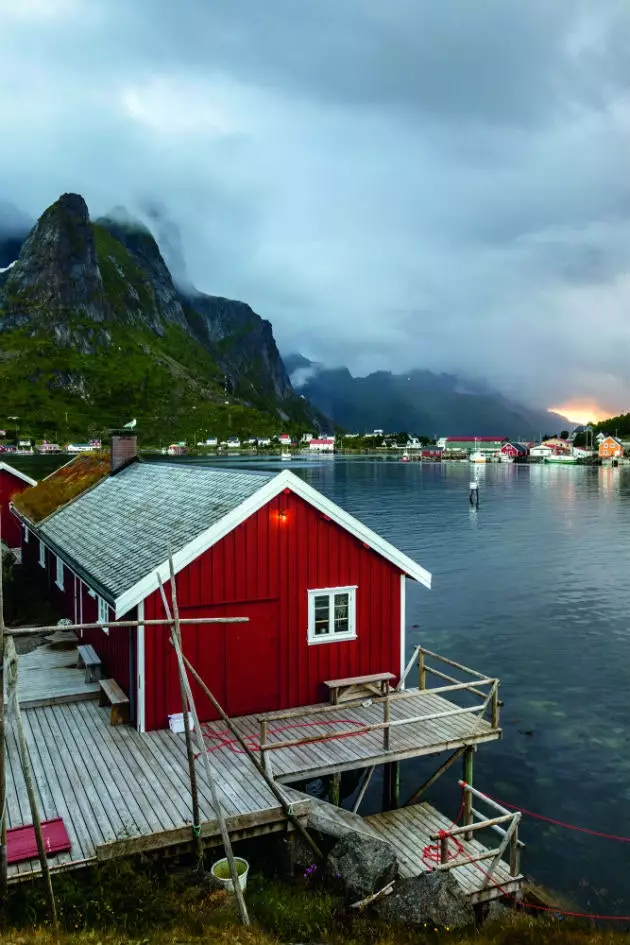
Views towards the pale amethyst colored sea dotted with rocks.
Gylseth was born here: his grandfather, in order to impress his future wife, was responsible for paint all the houses on the neighboring island of Sakrisøy orange –Ochre, being an imported pigment, is considerably more expensive than the usual iron red–. It worked. As I arrived out of season, the hotel restaurant was not open yet.
Gylseth had been visited by some friends from Oslo and he asked me if he wanted to join the group. We ate out with woolen blankets on top, cauliflower soup, salted cod, a stew of dried cod and several pieces of a leg of lamb roasted on the bone, each thin slice had its own yellow fat crust . The talk ranged from Norwegian sweaters (everyone but me was wearing the same one, as in some kind of family worship) and the musicality of the Lofoten dialect, which drops the ends of words, which is perfect for calling someone – okay , maybe not your grandmother– hæstkuk (or 'horse penis') , but that won't help you too much to get your hands on your neighbor's arctic berries.
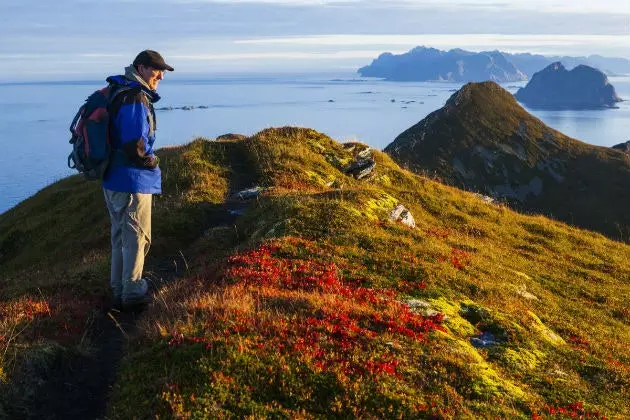
Sunrises in Lofoten.
I also got to visit Å, but since it was not the season, everything seemed very sad to me: it is a museum town , probably great in summer. However, after wandering among the last empty cod liver cauldrons, watching seagulls nest on the doors of the old fish factory, and watching Boney M's Mary's Boy Child video in the bakery, I decided I was done. time to move on.
Much better is to get on a fjord ship to puff on the edge of a remote village awaiting the delivery of mail and supplies. On board one of them, an islander told us about an old woman who lives on one of the islands and has never left it . I repeat, never. She has never been sick and her orders arrive by ship . The other passengers exclaimed and began to wonder what had kept her there for so long, what kind of life would she lead, and why would she have chosen to take her. I don't know. Maybe, if I weren't from a small town just as small, it wouldn't seem so crazy to me.
This article is published in the December issue of Condé Nast Traveler magazine, number 79. This issue is available in its digital version for iPad in the iTunes AppStore, and in the digital version for PC, Mac, Smartphone and iPad in the Zinio virtual kiosk (on Smartphone devices: Android, PC/Mac, Win8, WebOS, Rim, iPad) . Also, you can find us on Google Play Newsstand.
